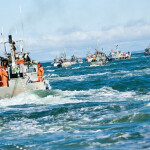Don't know about you, but I'm pretty eager to rip my calendar off the wall and ring in a new year. However, 2013 did happen, so here's a quick rundown of the 10 most important news stories to affect the U.S. seafood industry (and one for me, personally) in the year that soon expires. Cheers, and make mine a double.
10. A sentimental choice kicks off my list, but it is my list. The early February passing of Mike Voisin, longtime leader of Motivatit Seafoods in Houma, La., was a very sad way to begin 2013. It's not lip service when I say that he was the most genuinely friendly, kind-hearted and helpful person I've ever met in this industry. Every time I ran into him (and there were many) his warmth, humor and generosity shined through, even through tears sometimes. He was real. When Mike looked you in the eye and shook your hand, he made you feel important — that buzzing phone in his pocket could wait until you were taken care of. The words I (often) quoted from him, not one of them negative, were always straight from his gigantic heart. I still can't believe that one of seafood's greatest gentlemen is gone, and way too soon.
9. One of the worst things about the government shutdown this fall, besides the federal
8. The Alaska salmon industry took a calculated risk by withdrawing support for the Marine Stewardship Council (MSC) in favor of the Responsible Fisheries Management certification system. After some time and a couple of fishing seasons, it doesn't seem like a bad move. Competition is good, and the MSC, though widely accepted as the gold standard of fishery certification, could actually become better with more options available. The buying position Walmart announced on the matter, which it later clarified, was unfortunate but it provided atypical insight into how major corporations view environmental criteria with regards to procuring natural resources. Sustainable seafood policies require nuance, not rigidity.
7. Speaking of Alaska, folks up there weren't too happy that Russia's pollock fishery gained MSC certification. The At-sea Processors Association was vocal in its opposition, but despite its complaints about Russia's fishery management system, the Sea of Okhotsk pollock fishery earned the blue eco-label. Keep an eye on this story, because we're talking about the largest whitefish resource (combined) in the world. Some might argue that MSC's credibility is on the line with this controversial certification.
6. While we're on the NGO subject, here's some good news: The Monterey Bay Aquarium's Seafood Watch program gave 95 percent of all U.S. fisheries either a green (best choice) or yellow (good alternative) rating. If anything, it's evidence that U.S. fishery management changes are meshing well with the aquarium's calculus. The stoplight system is far from perfect. And it's probably too simplified. But these ratings are powerful, they're here to stay and they are likely to impact your business in some way.
5. This summer I wrote about labeling laws for genetically modified organisms, or GMOs, and how seafood could potentially be affected (not just transgenic fish, but GM feed ingredients too). The flashpoint for this issue is without a doubt AquaBounty Technologies of Maynard, Mass., and its AquAdvantage salmon, which grows to market size in about half the time as a conventional farmed salmon. More than a million people who oppose this technology wrote to the U.S. Food and Drug Administration during the public comment phase, and the agency has not yet cleared its path to market. But now that Canada has given the green light for production, this product could make an indelible mark on the industry in the future. Someone's going to embrace this technology, and probably make a bundle. Who will do it first?
4. Only big-time mergers get on this Top 10 list, and they're usually on the supply side (think High Liner Foods acquiring Icelandic USA in late 2011). Rarely do you see a buyer merger like Sysco acquiring rival distributor US Foods, a deal that some fear could cripple the
3. That thud you heard in late October was the U.S. per-capita seafood consumption figure falling yet again. Down to just 14.4 pounds, it's a 4 percent drop from the previous year and the sixth straight year of declining consumption. Somehow being "Stuck at 16," like we used to complain about, doesn't seem so bad right now. U.S. fisheries are in good shape (refer to No. 6) but American consumers just aren't getting the message that eating seafood at least twice a week is one of the best things they can do for their health. Any ideas on how to reverse this trend? Comment on it below, because I got nothing.
2. I'm not in favor of trade barriers (read No. 9). Every industry, when pushed to the brink, needs to utilize all tools in the box, if necessary, to preserve a way of life. I get that. But the U.S. shrimp industry was unsuccessful this time around when it sought countervailing duties (CVDs) on shrimp imports from seven top producing nations. This was a close call: Just when it seemed like they might be successful in proving unjust harm in the form of illegal subsidies overseas — the U.S. Department of Commerce announced preliminary duties back in May, causing panic in the market — it all fell apart when the U.S. International Trade Commission voted down the CVDs in September by a 4-2 vote. The domestic industry vows to keep up the legal fight, but this task may be too tall and another strategy might serve them well.
1. If you're a shrimp importer, then you probably have heard the name Dr. Donald Lightner. He's the University of Arizona veterinary science professor who spearheaded the key research that led to a breakthrough on fighting early mortality syndrome (EMS) in farmed shrimp. Identifying and understanding the phage-infected bacterium that causes EMS is only the start — wiping out the disease could take time. Supplies have been hit hard in Southeast Asia, and the impact on pricing has been dramatic. What does the future hold for America's favorite seafood?





